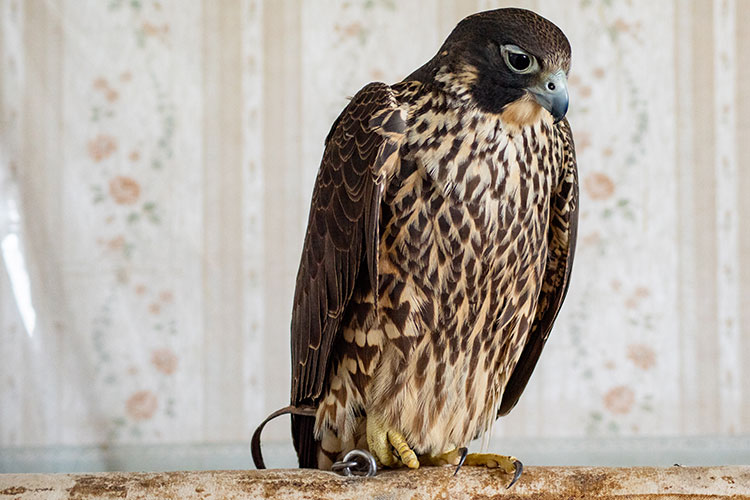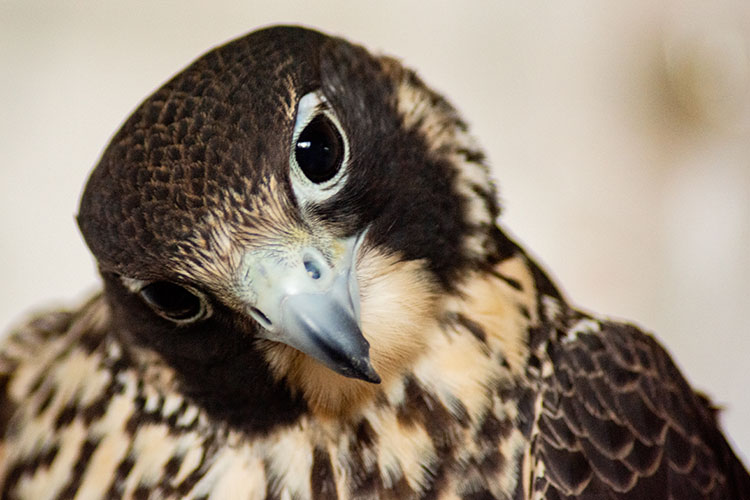Helen the Peregrine Falcon
Helen the Peregrine Falcon arrived from a breeder in February of 2019
and was added as an educational bird on March 4th, 2019

|

|
Helen's Biography
- Hatch Date: End of May 2018
- License Date: July 28th, 2019 Officially a Wildlife Ambassador for the Southwest Wildlife Foundation of Utah.
- Common Name: Peregrine Falcon
- Scientific Name: Falco peregrinus It means the gentle falcon.
- Group: Falco. She's in the group with all Falco from smallest Kestrel Falcon all the way up the largest in the world which is the Gyrfalcon.
- Weight: 27 to 28 ounces
- Wingspan: About two to two and half feet
- Diet: Her diet is primarily birds. Though she does eat rodents as well. We order in frozen quail, rats and mice. And I do have pigeon breeders, that when they cull their pigeon flocks, they donate the pigeons for food for the wildlife. So she does get pigeon to eat as well.
|
|
|
- Activities:
Activities are very limited for her, unfortunately. Usually, our wildlife ambassadors are also my falconry birds. So they get a chance to fly free. The hunting season is September through February so they get to go hunting like a wild falcon does.
Because of Helen's vision problems, even though she's not completely blind, she's mostly blind. We can't allow her to fly because she can only see about six feet ahead of her. She would basically run into walls. As soon as she took off she would lose sight of me...and she couldn't find her way back.
So she cannot be allowed to fly.
So mostly her daily activities is just kinda hanging around with me.
She does love, in the evening times, when we're relaxing here in my living room and we've got the television on. She loves to watch TV.
She likes to watch the movements and the lights and the colors.
So she spends quite a bit of time up with me sitting in the recliner chair and watching television to get lots of stimulation.
She travels with us as a wildlife ambassador. So she gets to meet thousands and thousands of people every year and help educate.
So it's mostly she is a wildlife ambassador, mostly sedentary, unfortunately.
But that's the best we can hope for because of her poor vision.
- Temperament: The Peregrine Falcon has one of the best temperaments of the large falcons. That's why it's Falco Peregrinus, the gentle falcon.
- Personality:
She does have a real sweet personality to her.
As far as an animal to work with, she's very quiet. She's very polite. A real pleasure to have. Because of her really calm disposition, she's perfect for school and scout programs.
Peregrine Falcons, are just like everybody else. You have some that are more high strung, some that are laid back. You have some that are more aggressive for hunting you, have some that are less aggressive for hunting.
Each of these animals have their own individual personalities.
As far as falcons go, generally speaking, the Peregrine is certainly one of the nicest ones to work with.
The Prairie Falcon, which is a falcon that I truly love to work with, are incredibly aggressive and they have a very nervous kind of a temperament. They are much more difficult to work with and so, like I said, the Peregrine, is one of the calmer and easier ones to handle.
- Story of Arrival:
I got a phone call from a breeder who breeds Peregrine Falcons.
He asked me if I had a need for another falcon for my educational programs. At the time I said "No, I don't need another falcon".
He said, "Well I've got this Peregrine, she's a young one, she's mostly blind, we can't do anything with her. We can't release her, she can't be used for falconry, she can't be used as a breeder. There's really nothing I can do with her. I guess I'll just have to euthanize her."
So I told him, "Bring her over, let me look at her".
He brought her over to me.
She's really quite beautiful. She's a pretty little thing. She's got a few little genetic things, a feather that's out of place, a talon that instead of turning down, it turns up. It's supposed to turn down, it's completely worthless, she can't grab with it. Along with her very very nearsightedness, nearly blind, she has no value at all in the wild.
She would have never left the nest. She would have never survived.
So he brought her over and she was a pretty little thing and a quiet little thing and I said, "Okay...let me contact the US fish and Wildlife Service and Utah Division of Wildlife Resources and get her added to my permits.
Each bird has its own accompanying documentation. Every one of my birds needs this for when we travel. It documents the age of the bird, where it came from, and its band numbers. The documentation proves the bird is legally possessed. These were an endangered species and highly protected. With all of the proper documentation, I travel around the country.
At my wildlife shows, if a game warden or a fish and wildlife agent walks up to me and says I need to see your documentation, then I've got an envelope full of all my state and federal permits. I can say, "Here you go." This proves the bird is who I say it is and that I'm doing this in a very legal way.
- Treats:
She does like, as far as activities are concerned, the tv. Like I said, because of her really poor vision.
With most birds, the TV kind of agitates them because there's so much movement and stuff. They have to get used to the television.
But Helen will watch the TV because all she sees are kind of blurs and colors and those kinds of things, so she does get entertained by watching the television.
She does really enjoy her personal time, just her and I sitting down and visiting together. Because her vision is so bad, the sound of my voice is very comforting to her. When she's out in her chamber or out in the yard, if she hears strangers, she gets a little bit nervous. But when she hears my voice, she calms down. She really likes the sound of my voice.
As far as food as a treat is concerned, food is a survival thing. It's not really a treat. She gets all the quail and mice and pigeons that she can possibly eat. She's really quite a chubby little girl because she doesn't have to hunt and so she gets all that she wants.
She's just kind of a pretty little couch potato.
- Life Expectancy:
In the wild a Peregrine Falcon like this, you would average about 7 to 10 years. In captivity, we can double that. We can go 15 to 20 years in captivity. I've seen Peregrine Falcons in captivity go 25, even close to 30 years.
|
|
Helen's ArrivalHelen came from a breeder, but Helen was also rescued. She has a couple issues that make her unable to be free or to be a falconry bird. The first problem is her vision. She is extremely nearsighted. If she tried to fly, she would not be able to see where she was going. Another problem is on her foot. One of her talons is in the wrong direction. And she also has one feather that hangs out of place. So Martin took her into the family and foundation as an Educational Bird. |
|
|
That Bird Named!Shortly after Helen arrived, we introduced her in a YouTube video, told everyone about her, then asked for name suggestions. We received many suggestions from which Susan and Martin selected their favorite. She was named Helen after three people: Martin's Grandmother, Martin's Granddaughter and Helen Keller. |
|
|
Helen the YouTube StarHelen a wonderful Wildlife Ambassador, Teacher, Friend and Family Member. She gets to spend a lot of time with Martin and Susan watching TV. Sitting close, despite her poor vision, she can still watch movements on the screen. Helen is a also a frequent guest on our YouTube channel during livestreams and unboxing videos. |


